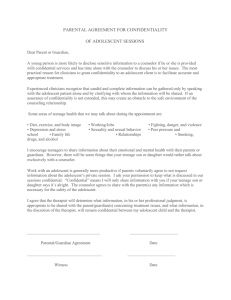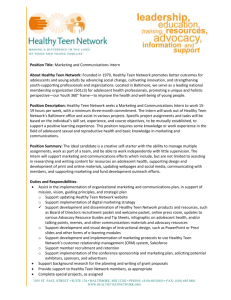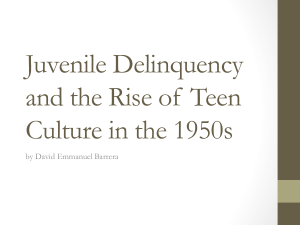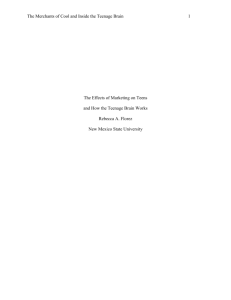Your Teen`s Brain: Fabulous Resources to
advertisement
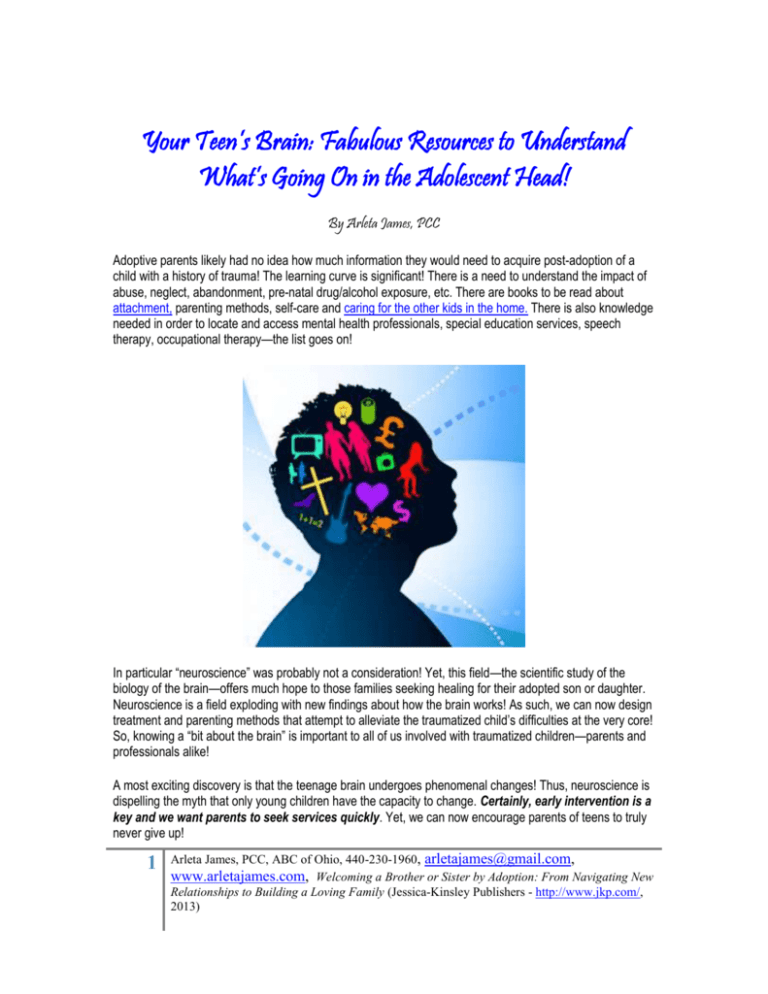
Your Teen’s Brain: Fabulous Resources to Understand What’s Going On in the Adolescent Head! By Arleta James, PCC Adoptive parents likely had no idea how much information they would need to acquire post-adoption of a child with a history of trauma! The learning curve is significant! There is a need to understand the impact of abuse, neglect, abandonment, pre-natal drug/alcohol exposure, etc. There are books to be read about attachment, parenting methods, self-care and caring for the other kids in the home. There is also knowledge needed in order to locate and access mental health professionals, special education services, speech therapy, occupational therapy—the list goes on! In particular “neuroscience” was probably not a consideration! Yet, this field—the scientific study of the biology of the brain—offers much hope to those families seeking healing for their adopted son or daughter. Neuroscience is a field exploding with new findings about how the brain works! As such, we can now design treatment and parenting methods that attempt to alleviate the traumatized child’s difficulties at the very core! So, knowing a “bit about the brain” is important to all of us involved with traumatized children—parents and professionals alike! A most exciting discovery is that the teenage brain undergoes phenomenal changes! Thus, neuroscience is dispelling the myth that only young children have the capacity to change. Certainly, early intervention is a key and we want parents to seek services quickly. Yet, we can now encourage parents of teens to truly never give up! 1 Arleta James, PCC, ABC of Ohio, 440-230-1960, arletajames@gmail.com, www.arletajames.com, Welcoming a Brother or Sister by Adoption: From Navigating New Relationships to Building a Loving Family (Jessica-Kinsley Publishers - http://www.jkp.com/, 2013) The purpose of this post is to point out resources that help describe the changes going on in the teenage head—brain. Knowing this information lends to improving parent-adolescent communication, and also causes a re-thinking of the types of support that best lend to helping the teen emerge from adolescence with the skills needed to navigate adulthood. Inside the Teenage Brain Let’s start with the PBS special, Inside The Teenage Brain. Like many PBS specials it can be viewed at your convenience via the PBS website! Through this special you will learn about the change that occurs in adolescent sleep patterns and the effect of sleep on teens’ memory. You will also learn about very interesting work that makes clear that teens view facial expressions more with their amygdala—the brain area that experiences fear, threat and danger, whereas adults use their pre-fontal cortex for this process—the area of the brain linked more to reason and judgment. In essence, teens are more likely to misread facial expressions—yours and others! Teens assign more emotional content to faces than is actually being conveyed. If you are living with a teen, you already know the end result of this situation! You aren’t angry, but your teen asks, “Why are you mad?” Subsequently, an argument ensues! We know that traumatized children have an amygdala that is over-sensitive. This is because these kids’ brains were exposed to more fearful experiences early in life, than non-traumatized individuals. The amygdala is prone to storing these emotionally arousing experiences long after their occurrence! Thus, we might speculate that the adopted adolescent’s abilities to effectively engage in facial recognition are even more affected than the typical teen. Just having this information can reduce the conflict that is often part of the adoptive home in which resides an adolescent! Again, knowing a bit about the brain can help all of us stay on a more even keel in our interactions with older kids! Interviews with Key Scientists Once you view Inside the Teenage Brain, you’ll want to take advantage of the interviews with key experts. Jay Giedd, National Institute of Mental Health, is of particular interest. He explains the “use it or lose it” manner in which the brain operates. Pruning is a process—that occurs in adolescence—through which the brain chooses to eliminate or keep various cells and connections. Those cells and connections that are used will survive and flourish. Those cells and connections that aren’t used will wither and die. This calls to light thought-provoking questions, What are the influences of parents, teachers, clergy, illness, nutrition, etc.? What kind of activity and activities are best for children? Video games? Sports? Recess? Dr. Giedd’s answers bring us back to some basics—spend loving, quality time with your kids, and increase the time spent in creative, free play. So, for adoptive families, building an attachment to your adopted son or daughter—no matter the age, and maintaining strong attachments with your typical kids is essential! If your family struggles with attachment issues, visit ATTACh and locate an attachment therapist near you. Evaluate how your family members spend time—is there enough time for play? Can your adoptee play? Review my articles, Does Your Child Really Play?: Finding Your Traumatized Adoptee’s Playful Side! , for ideas about building the social skills of the formerly traumatized child. 2 Arleta James, PCC, ABC of Ohio, 440-230-1960, arletajames@gmail.com, www.arletajames.com, Welcoming a Brother or Sister by Adoption: From Navigating New Relationships to Building a Loving Family (Jessica-Kinsley Publishers - http://www.jkp.com/, 2013) The Teen Brain: It’s Just Not Grown Up Yet This brief NPR interview, with Frances Jensen, sets the tone for understanding that the teen brain is not an adult brain. Bolster the content of this interview with the article, The Adolescent Brain: A Work in Progress, or the book, Inside the Teenage brain: Parenting a Work in Progress. Learn that during adolescence the pre-frontal cortex is still growing and maturing. As stated above, the pre-frontal cortex—the “CEO” of the brain—is responsible for planning, organizing, strategizing, reasoning, allocating attention, curbing impulsivity, making judgments and so on. It isn’t until our 20’s that the pre-frontal cortex is complete. This means that getting organized in the morning with a backpack and lunch, or remembering to take the trash out might not occur! More seriously, this may mean that the use of drugs and alcohol lend to becoming addictions more quickly for the adolescent than the adult. There are many ways that drugs can alter or damage the development of the adolescent brain, Firstly, drugs often target and alter function of neurotransmitters—the chemical messengers that allow nerves to communicate. Illegal substances interfere with these neurotransmitters, and thus directly damage the connections forming in the developing brain. Many of these connections are needed for adequate thought processes. Secondly, use of these substances alters perception and may interfere with the developing perceptual skills. And finally, the habits and choices associated with the use of drugs and alcohol slowly become ingrained in the wiring of the brain. Repeated action becomes habit and the habits of thought, perception, and reasoning developed in childhood and adolescence can stay with a person throughout his or her lifetime—again, the “use it or lose it” principle! (SAMA Foundation, online.) Know as much as you can about your adolescent’s friends and activities. Show him or her the information in this blog post. Watch Inside the Teenage Brain together. Adolescents need to receive information from multiple sources—they especially like to “see” for themselves, rather than “hear” from adults. Offer them KidsHealth articles written especially for teens, Drugs: What You Should Know? I Think I May Have a Drinking/Drug Problem. What Should I Do? Take the time to read some KidsHealth articles yourself, Talking to Your Child About Drugs Drugs: What Parents Need to Know Tune your kids into Drug Facts 4 Young People and Students Against Destructive Decisions (SADD)— website or facebook. In conclusion, the teenage brain is simply bursting with growth! Learning about what is going on inside the teen’s head offers ideas about coping and much hope for healing! Go ahead—click on a few links and forge into the field of neuroscience! “Use it” to improve the emotional climate of your home, and your adoptee’s mental health! 3 Arleta James, PCC, ABC of Ohio, 440-230-1960, arletajames@gmail.com, www.arletajames.com, Welcoming a Brother or Sister by Adoption: From Navigating New Relationships to Building a Loving Family (Jessica-Kinsley Publishers - http://www.jkp.com/, 2013) 4 Arleta James, PCC, ABC of Ohio, 440-230-1960, arletajames@gmail.com, www.arletajames.com, Welcoming a Brother or Sister by Adoption: From Navigating New Relationships to Building a Loving Family (Jessica-Kinsley Publishers - http://www.jkp.com/, 2013)




